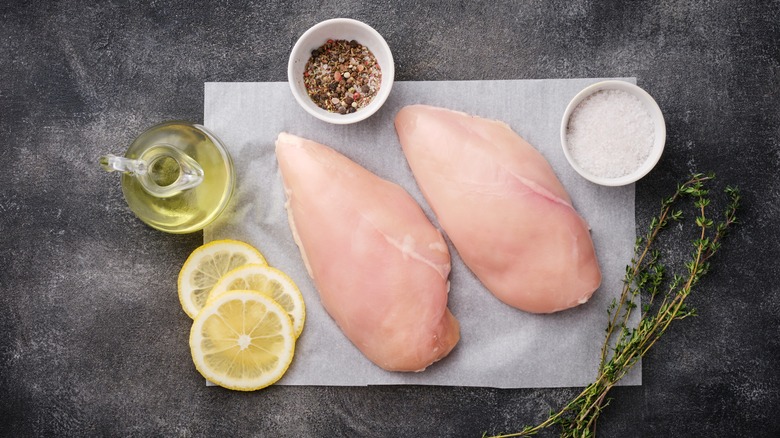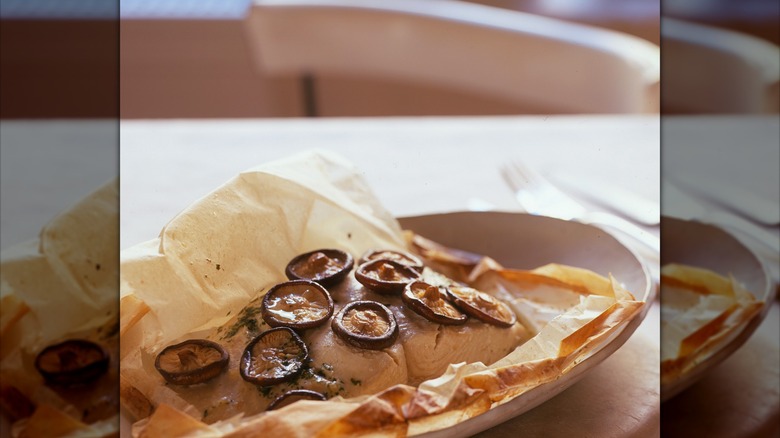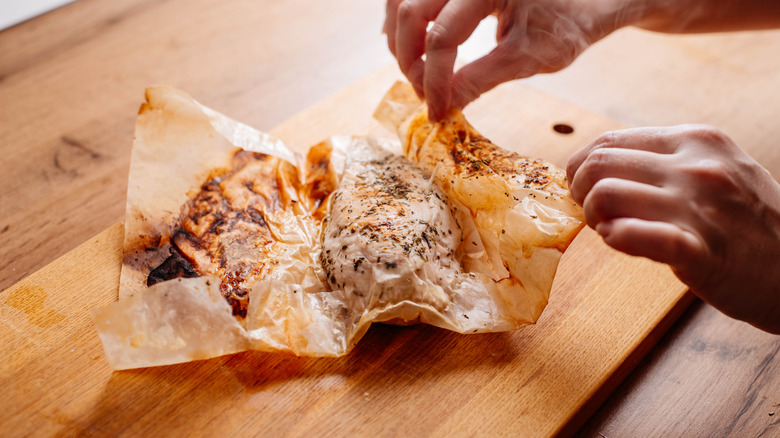Why Cooking Chicken In Parchment Paper Is A Game-Changer
We may receive a commission on purchases made from links.
Baking chicken breast often involves a bit of resignation. It's relatively quick and easy, and chicken breast is a filling, healthful protein. But even nicely seasoned, it can get a bit mundane and the risk of overcooking and drying out the meat is significant. There are lots of ways to upgrade the flavor of chicken breast, and tricks to avoid overcooking them. But baking your chicken in parchment paper is a hack you may end up using from here on out.
Essentially, you're sealing the chicken breast inside a heat-resistant parchment paper (not wax paper, which could melt) parcel and both roasting and poaching the meat to tender, juicy goodness. Also called en papillote, it's a technique more commonly associated with cooking fish, particularly salmon. But it works well with a variety of lean proteins, including chicken and pork loin. With chicken breast, not only does it prevent it from drying out, but herbs and flavorings infuse nicely into the meat. The finished product is not only delicious on its own, but is easily shredded for chilis, tacos and salads.
Why cooking in parchment paper works so well
This technique works because the sealed pouch traps the natural moisture found in lean meats, along with any added moisture from citrus slices or vegetables, to create steam which can't escape. Instead it not only helps cook the meat quickly, but infuses it with moisture and flavor. The sealed pouch cooking method amplifies flavors and aromatics from any added ingredients in a way that baking in an open dish can't. The finished chicken breast will be juicy, tender, and intensely flavored, and there's no need for added oil (unless you want).
Wrapping individual chicken breasts in their own parchment paper envelope allows for creative presentation as well. You can cut the packets open when you pull them from the oven, or open at the table to release savory aromatics to tantalize hungry guests. Set the whole packet on a plate or bowl. Once cut open, spread paper revealing the chicken and creating a rustic, visually appealing service.
There's another benefit: Cleanup is significantly easier. Just as lining a baking sheet with aluminum foil helps with cleanup, everything here is contained inside the parchment paper, which is water resistant and sturdy. It may seem odd to place paper in a hot oven, but it's specially treated for exactly this purpose. Once you've removed the meat and any veggies you wish to keep, pull the whole thing up and discard everything into the compost bin or trash.
Tips for cooking chicken breast en papillote
The most important trick in cooking in a parchment packet is creating a tight seal all the way around the chicken, so the steam and liquids stay trapped inside. The classic way to do this is to fold your parchment paper in half and cut out a half-heart shape (like making a Valentine's Day decoration). Make the paper large enough that when you place the chicken and seasonings on one half of the heart, and fold over the other half, not only can you crimp the edges tightly, but there's a bit of a pocket allowing steam to build.
Before sealing, add herbs, seasonings, citrus, vegetables and extra liquids. It's not mandatory to add a splash of lemon juice or wine, but it brings added moisture to the process, and can enhance the flavors of the added ingredients as well. By the way, despite the fact the term en papillote means "in paper," even the experts say aluminum foil works nicely.
It's worth noting that meat doesn't brown with this method. So if you want a bit of color, sear it briefly on a pan or hot grill. When checking for doneness, minimize steam loss by poking a digital thermometer, like the Alpha Grillers instant read meat thermometer, through the folded (not sealed) side into the center of the breast to ensure it's reached 165 degrees Fahrenheit. If it's not ready, push the pierced packet against your baking dish and continue cooking.


